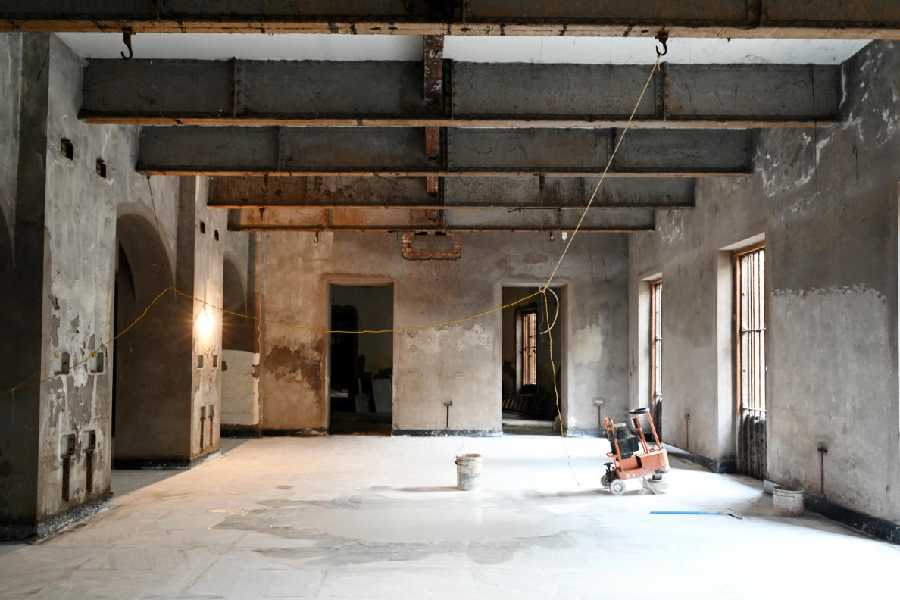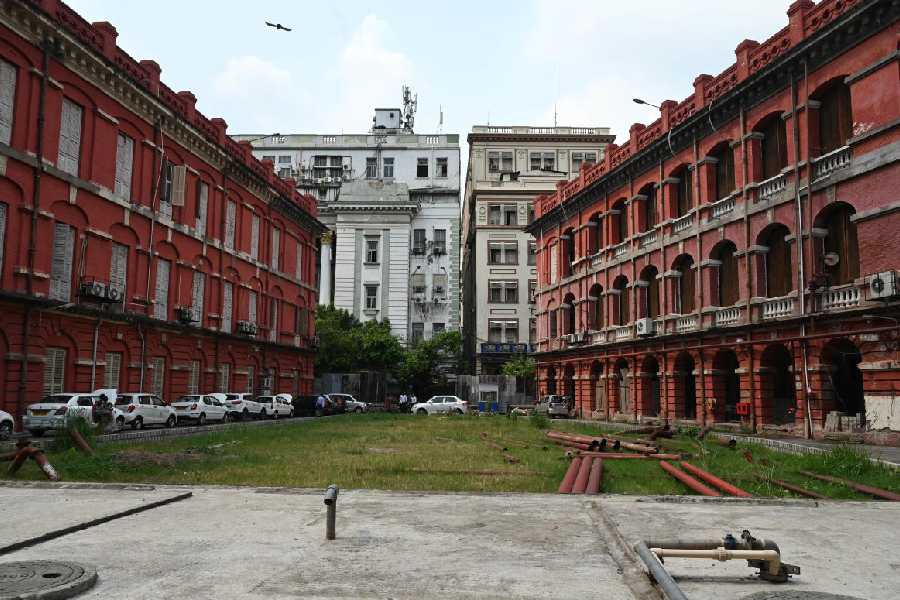Since it was designed in 1777 by Thomas Lyon and opened for the East India Company in 1780, Calcutta’s Writers’ Buildings — or Writers’ as it is commonly known — continued to grow. From being a simple three-storey building with one main block and five other blocks meant to house writers or junior servants of the East India Company, it turned into a complex structure. After Independence, eight more blocks came up to accommodate more offices. The workspace increased to nearly 5.5 lakh square feet.
The alterations in structure were not ornamental; they had to do with the demands made of the centrally located Writers’. At one point, the Fort William College moved here and that explains why hostels, exam and lecture halls, and a library came up. At another point, the East India Railway had its offices here. Writers’ used to house the principal offices of the British government and after Independence, it became
the office of the chief minister of West Bengal, his ministers and senior officers of various departments. In fact, the entire neighbourhood now takes its name from a piece of Writers’ history — in 1930 Benoy, Badal, Dinesh after whom the area BBD Bagh is named, entered Writers’ and shot dead the inspector-general of prisons, Lt Col N.S. Simpson.
With the continuous construction of new buildings, Writers’ spread from the original 10
bighas of land to over 16 bighas and 17 cottahs.
Retired bureaucrats, who had worked at Writers’ during the early 1970s, tell The Telegraph how the buildings were the nerve centre of the state administration in their time. “As the entire state was run from Writers’ Buildings, all ministers and officers wanted to have their offices there. As a result, large office rooms were divided into small office rooms with the help of temporary partitions in addition to construction of new blocks,” says a bureaucrat, who retired as the chief secretary.
It was the seat of power, true, but its unwieldy, stuttering expansion increasingly made Writers’ a fire hazard. Newspapers routinely reported fires in the offices of the information and cultural affairs department or the anteroom of some minister or the visitors’ room. From the late 1990s, the fire department and the police started sending recommendations to the state government to decongest the state secretariat. The Left Front government finally took cognisance of these recommendations in early 2000.
There were outcries of protest from employees over the impossible commute this shift necessitated, but the shifting continued; the then chief minister of West Bengal, Buddhadeb Bhattacharjee, was dead serious about it.
But the Left Front government did not have a proper plan as to how the buildings would be renovated. Between 2000 and 2011, the state government had shifted some departments — there were 34 in all — including health and family welfare, and commerce and industries out of Writers’. But it could not oust departments such as Paschimanchal Unnayana affairs and animal resources development despite repeated attempts. “The departments did not want to move out from Writers’ as no proper alternative was offered,” said a senior bureaucrat.
In May 2011, the Trinamool came to power with its parivartan chant. It took up the issue in right earnest. Perhaps it had to do with the fact that the new chief minister was never comfortable in Writers’. Some say it has to do with the damp and dark rooms, some others put it down to lack of privacy and security issues. Whatever the reason, Mamata Banerjee’s government prepared a detailed plan before shifting the state headquarters to Nabanna. According to it, Writers’ was to be decongested and several of the wings that had come up post-Independence were to be razed.

Work in progress
Within 45 days of oath-taking, the shifting process had begun. By October 2013, the 15-storey Nabanna was home to the chief minister’s office and departments such as finance, home, land and land reforms, minorities affairs, PWD and disaster management.
The renovated structure was to have only three lakh square feet area with spacious chambers for employees, officers and ministers.
According to multiple sources though, 25-30 per cent of the set target has been achieved. “It was supposed to be over in six to nine months after the work began in December 2013,” says a source. Senior state government officials who do not want to be identified attribute the continuing delay to a lack of political will. “If you know the top boss is not interested, why would you waste your time and resources,” says a senior officer.
And yet, on paper, there is a high power committee headed by the chief secretary that is supposed to look after the progress of renovation work. After the last meeting in January 2015, the committee met again this May. The meeting, chaired by chief secretary B.P. Gopalika, was not very productive, says a source who was present at the meeting.
“If the chief minister was interested in coming back to Writers’, the officials would have taken initiative,” says a source. No fund has been allotted for the renovation yet. All work is being carried out from the annual maintenance funds. The maintenance fund is a little over ₹1 crore annually. The latest estimate by the PWD suggests that it will require more than ₹102 crore to complete the work.

Work in progress
“Is it a huge amount for a government that spends over ₹30,000 crore annually on welfare schemes,” asked a bureaucrat. And so, Writers’ with its wealth of history, art, architectural styles and square feet upon square feet continues to await resuscitation. “We should not ignore the past. This historic building from where Bengal was ruled since Independence deserves some attention,” says a source.
But if work continues at the current pace, it may take another 20 years to complete the renovation of Writers’.










